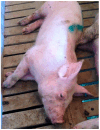Practical Review on Aetio-Pathogenesis and Symptoms in Pigs Affected by Clinical and Subclinical Oedema Disease and the Use of Commercial Vaccines Under Field Conditions
- PMID: 40805065
- PMCID: PMC12345458
- DOI: 10.3390/ani15152275
Practical Review on Aetio-Pathogenesis and Symptoms in Pigs Affected by Clinical and Subclinical Oedema Disease and the Use of Commercial Vaccines Under Field Conditions
Abstract
The impact of Oedema Disease produced by Shiga toxigenic Escherichia coli (STEC) in swine is increasing in some production countries due to increasing limitations on treatment with antimicrobials and zinc oxide, either because of the increased prevalence of multi-resistant strains or because of legal restrictions. The main pathological effect of Shiga toxin 2e is represented by damage to the endothelial cells of the blood vessel walls, leading to liquid extravasation and oedema formation in multiple tissues. These oedemas are generally easily identifiable in acute clinical cases. However, disease caused by Shiga toxin can occur without any externally visible oedema in the pigs, as observed in the subclinical presentation of Oedema Disease. It also causes productive losses, so it is important to identify and/or diagnose cases to set up control measures in order to optimize production and health. This article includes a comprehensive review of lesions and signs caused by Shiga toxin toxicosis in pigs, as well as other insights about the aetiology and epidemiology of STEC in pigs, and the effect of Shiga toxin recombinant toxoid vaccines in reducing these clinical and subclinical signs under field conditions.
Keywords: EDEC; STEC; Shiga toxigenic Escherichia coli; Shiga toxin 2e; Shiga toxin vaccine; Stx2e; edema disease Escherichia coli; oedema disease; oedema disease vaccines; recombinant Shiga toxin; subclinical oedema disease; verotoxin.
Conflict of interest statement
The authors declare that they work as the technical and marketing teams of HIPRA, which has a recombinant Shiga toxin Stx2e-based vaccine in its portfolio.
Figures






References
-
- Fairbrother J.M., Nadeau É. Colibacillosis. In: Zimmerman J., Karriker L., Ramirez A., Schwartz K., Stevenson G., Zhang J., editors. Diseases of Swine. 11th ed. Wiley-Blackwell; Hoboken, NJ, USA: 2019. pp. 807–834. - DOI
-
- Wang X., Yu D., Chui L., Zhou T., Feng Y., Cao Y., Zhi S. A Comprehensive Review on Shiga Toxin Subtypes and Their Niche-Related Distribution Characteristics in Shiga-Toxin-Producing E. coli and Other Bacterial Hosts. Microorganisms. 2024;12:687. doi: 10.3390/microorganisms12040687. - DOI - PMC - PubMed
Publication types
LinkOut - more resources
Full Text Sources

